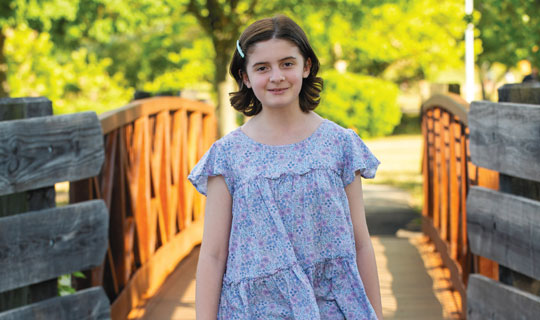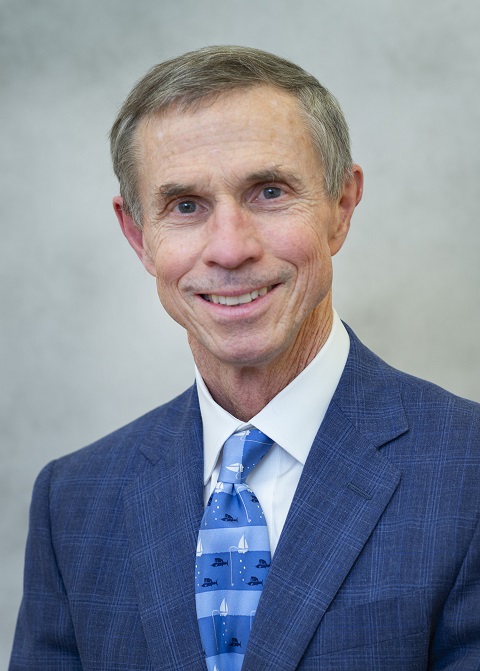“You never want to put your child through surgery, but we realized this was the best time in the best place with the best surgeon. I wouldn’t change a thing.”

A girl’s severe scoliosis leads to surgery—and inspiration for a future career.
In summer 2023, Jane and Walter Pabon of Sayreville noticed something different about their now-11-year-old daughter, Meredith. “Even when she was sitting up straight, it looked like there was a bump on one of her shoulders,” says Jane.
When the deformity grew larger, the Pabons took Meredith to the doctor, who made a startling diagnosis: Meredith had scoliosis, an abnormal sideways curve in the spine that often emerges in childhood or adolescence and is particularly common among girls.
Suddenly the Pabons needed specialized pediatric care that went beyond a normal trip to the pediatrician.

Meredith was referred to J. Andrew Bowe, MD, Chief of Pediatric Orthopedics at The Bristol-Myers Squibb Children’s Hospital (BMSCH) at Robert Wood Johnson University Hospital—part of the Children’s Health network at RWJBarnabas Health—and a member of RWJBarnabas Health Medical Group. BMSCH was named among the Best Children’s Hospitals for 2023-2024 by U.S. News & World Report, which ranked the hospital 34th nationally for pediatric orthopedics, and Dr. Bowe has expertise in conditions such as scoliosis.
Dr. Bowe took a progressive approach that started with conservative measures. These included seven months of physical therapy along with use of a specially fitted brace to hold Meredith’s spine in place.
Such measures are often successful in holding scoliosis at bay but ultimately couldn’t forestall the worsening of Meredith’s spinal curvature. “She had a severe torso shift to one side because of progressive scoliosis,” says Dr. Bowe.
Timely Treatment
Meredith’s scoliosis wasn’t uncomfortable and didn’t make movement overly difficult. But it’s important to correct the problem at the right stage of development, Dr. Bowe notes.
“Teenagers won’t necessarily have a lot of pain,” he says. “But if scoliosis is left untreated and progresses into adulthood, they will see further worsening of their condition, increased deformity and the onset of back discomfort.”
In addition to these concerns, young patients tend to become self-conscious about their appearance when scoliosis becomes more obvious and clothing starts to fit less well, says Dr. Bowe.
The family took all these concerns to heart and scheduled Meredith for spine surgery at BMSCH. She and her parents were understandably nervous, but a trip to the hospital beforehand helped calm their anxieties.
During the initial tour and rundown of what was going to happen, they let us walk the floor and see the rooms where Meredith would be,” says Jane. “That put all our minds at ease.”
Meredith, who loves swimming and creating art, was especially struck by activities available to recovering patients. “When she saw there was a room with video games and art supplies, she was hooked,” Jane says. “That was something to focus on beyond the surgery.”
The successful seven-hour procedure in March 2024 involved both implanting two rods to straighten Meredith’s spine and performing a spinal fusion in which bone grafts are used to encourage new bone growth.
Meredith spent five days in the hospital but quickly began recovering. “Even though it was a major surgery, she was up and moving the first day,” says Jane.
Child Life Specialists
During recovery, Meredith was struck by something else: the impact of interactions with child life specialists.
“These are professionals who try to allay some of the angst that children may experience by engaging them and getting them to worry less about treatment,” says Dr. Bowe.
“We use a lot of different interventions to help the child and family cope,” says Barbara Romito, Director of Child Life and Family-Centered Care at BMSCH. “These include teaching children about their condition in an age-appropriate way, preparing them for surgery and guiding them through pain management techniques such as relaxation, guided imagery and distraction.”
The activity lounge in the adolescent unit and a playroom in the pediatric unit offer settings for recreational activities. “Our goal is to normalize the hospital experience and offer emotional support to the entire family,” Romito says.
One or two child life specialists came to Meredith’s room each day to talk and answer questions, get her walking, encourage activities and allow her parents to occasionally step out.
The support made a big impression on Meredith—in fact, she is considering becoming a child life specialist herself someday, beginning as a volunteer in the department. Volunteers can start at age 18. “She is counting down until that birthday,” Jane says.
Back home, Meredith’s recovery rapidly progressed. “Within a month or so, she was back to normal,” Jane says. “You never want to put your child through surgery, but we realized this was the best time in the best place with the best surgeon. I wouldn’t change a thing.”
Expert Therapy for Scoliosis
Physical therapy (PT) often plays a key role in treating scoliosis. That’s why RWJBarnabas Health offers a highly specialized PT technique called the Schroth method that helps children counteract spinal curvature and realign posture.
“It addresses scoliosis on a three dimensional level,” says Karen Cohen, MPT, BSPTS-C2, a Schroth therapist at Children’s Specialized Hospital (CSH). “While scoliosis is a curvature of the spine, there’s also a rotational component, and this therapy addresses that.” A certified therapist helps patients locate and retrain muscles involved with posture to elongate and straighten the spine while doing special breathing exercises.
Schroth-certified therapists are available at CSH outpatient centers in East Brunswick and Toms River, and at Cooperman Barnabas Medical Center in Livingston.
Learn more about the Children’s Health network at RWJBarnabas Health.
 View full issues of Healthy Together magazine by New Jersey region:
View full issues of Healthy Together magazine by New Jersey region: